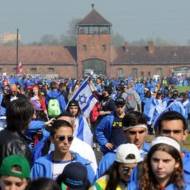

Forced by the Nazis to relocate to the Krakow Ghetto, Jews move their belongings in horse-drawn wagons. (Historyplace.com)
Is it beautiful to see Jews on the streets of Krakow again, where so many died? Or is it just a giant cemetery?
So many Jews know what it is to have lost family members in the Holocaust. As the entire community upholds the memory of the six million victims, as well as hundreds of thousands of survivors, pilgrimages to the myriad European sites are often a top priority for Jewish people today.
Poland was among the countries that suffered most during this tragic time. 3,300,000 Polish Jews perished at the hands of the Nazis, and non-Jews also suffered many losses as the Germans occupied their country.
Krakow, one of Poland’s largest and oldest cities, became the Nazis’ Polish capital and housed the Krakow Ghetto, one of the five largest Jewish ghettos in Europe. Though the area was only built for 3,000m it became home to about 15,000 individuals as the Nazis attempted to sequester the city’s Jewish population. Multiple families had to cram into tiny apartments, while many were forced to live in the street with almost no sustenance.
Starting on May 30, 1942, the Nazis began deporting residents of the ghetto to extermination camps. By the following year the ghetto was completely “liquefied” – 11,000 Jews had been shipped to their deaths and another 8,000 to labor camps. The remaining 2,000, deemed unfit for work, were either sent to Auschwitz or shot in the streets of Krakow.

Inside the Krakow Ghetto (Wikipedia)
Outside of the city, the Nazis were massacring entire Jewish villages like Lask and Vishnev, shooting or burning people alive in their temples.
Memorials to the astounding loss of life pepper Krakow and other Polish cities. In Zgody Square – now called the Square of the Heroes of the Ghetto – thousands of Jews were lined up before being herded onto trains to the camps. Today, statues of chairs stand silent among the cobblestones, symbolizing those who died and the emptiness they left behind.
This and many other locations in Poland have become pilgrimage sites for descendants of survivors and victims. “Just knowing that I’m in the same land that they lived in, on the same land they walked on, it’s a crazy feeling,” said one such visitor. “It’s definitely really emotional.”
“It’s hard to get pleasure without it being mixed with deep, deep pain,” says famous Harvard law professor and author Alan Dershowitz, whose family members lived in Krakow and were ultimately killed. “When you think of the thriving Jewish life that existed here for a thousand years, and how quickly it ended, it makes us all appreciate what we have – and also worry and prepare for the eventualities of the future.”
By Maya Bornstein/Virtual Jerusalem
Subscribe to Our FREE Newsletter for More Great Stories Like This One
United with Israel publishes stories like this every day. We believe that our work allows a more balanced view of Israel to emerge. With so much anti-Israel media bias out there from outlets like CNN and the BBC, helping the Holy Land means getting our message out to as many people as possible.
You can help.
Subscribe to our free newsletter to ensure that you get the latest and best stories from United with Israel. Together we can make a difference, and it starts with communication.
CLICK HERE TO SUBSCRIBE TO OUR FREE NEWSLETTER
Source: United with Israel


